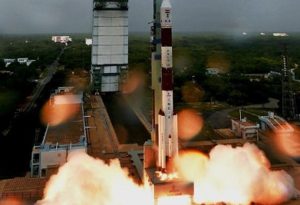
India’s space agency ISRO has created history by launching record 104 satellites in a single mission through its workhorse launcher Polar Satellite Launch Vehicle (PSLV-C37) rocket.
PSLV-C37 lifted off at 9.28 hours IST from Satish Dhawan Space Centre (SDSC) SHAR Sriharikota in Andhra Pradesh on Wednesday, February 15, 2017. PSLV carried with it 104 satellites, including the 714-kg Cartosat-2 Series satellite. Of the #104 satellites, only three are Indian satellites (#Cartosat-2D, INS-IA and INS-1B nanosatellites) and remaining 101 are foreign ones (88 Dove cubesets from Earth-imaging firm Planet and 13 nanosatellites from nations like Israel, Kazakhstan, Switzerland, and the Netherlands. It was touch and go for the mission as the Indian space agency switched the angular degrees at which the nanosatellites were released to avoid collisions in the orbit. Three heavier satellites were released separately along the launcher’s axis, and the remaining satellites were ejected radially at different angles.
This successful completion of the mission has made the Indian space agency first in the world to launch record number satellites. #ISRO beat previous record of 37 satellites created by Russia in June 2014.
On Monday, ISRO’s mission readiness review committee (MRRC) and the launch authorization board gave the go ahead for launch of PSLV-C37. The 28- hour countdown started at 5:28 am on February 14, 2017.
The launch event was telecast live on Doordarshan from Sriharikota on Wednesday beginning at 9:00 AM IST. The webcast was also available on ISRO’s website.
This was the 39th flight of ISRO’s workhorse PSLV that placed the satellites in an orbit 505 km above the Earth. #PSLV-C37 launch was earlier scheduled for January, but then ISRO postponed the mission to February. For ISRO scientists, this mission was different compared to previous missions as the focus was on executing the idea of utilizing the “excess capacity available on the PSLV.” The PSLV has a payload capacity of over 1,500 kgs, although the rocket carried only 1,360 kgs on this mission. According to ISRO scientists, this launch allowed the space agency to test its capabilities for multiple launches of smaller satellites. The successful launch is now expected to provide ISRO an opportunity to capture a share in the global market for nano and micro-satellites. According to experts, near 3,000 satellites are expected to be ready for launch in next 10 years, while the global market for launching of such satellites will grow to about $3 billion in next three years.
PM Narendra Modi and President Pranav Mukherjee Congratulate ISRO
Prime Minister Narendra Modi has congratulated ISRO on this achievement.
“Congratulations to @isro for the successful launch of PSLV-C37 and CARTOSAT satellite together with 103 nano satellites!” the Prime Minister tweeted.
“This remarkable feat by @isro is yet another proud moment for our space scientific community and the nation. India salutes our scientists.”
Mr. Modi also congratulated the Secretary of the Department of Space for “exceptional achievement.”
“Spoke to the Secretary, Department of Space and congratulated him & the entire team of scientists on today’s exceptional achievement,” he tweeted.
India’s President Mr. Pranav Mukherjee also congratulated the Indian space agency and the entire team of scientists for launching 104 satellites in a single mission.
“Congratulations to ISRO on the successful launch of PSLV-C37, carrying a record 104 satellites,” the President tweeted.
“This day shall go down as a landmark in the history of out space programme,” he added.
“Nation is proud of this achievement, which has demonstrated, yet again, India’s increasing space capabilities,” the President added.
“I urge ISRO to continue to strive for the progress of our space capabilities.”
History of ISRO
Founded in 1969 and headquartered in Bengaluru, ISRO is the space agency of India that was created with an aim to lead India in space science research and planetary exploration. The vision of ISRO is to “harness space technology for national development”.
Prior to ISRO, Indian National Committee for Space Research (INCOSPAR), created in 1962, was responsible for managing space research program in India. India’s Department of Space, which reports to the Prime Minister of India, manages all the activities of ISRO.
India’s first satellite, Aryabhata, was made by ISRO. Named after Indian mathematician Aryabhata, the satellite was launched in 1975 by the Soviet Union. In 1980, ISRO got success in placing the Rohini satellite in orbit using an Indian-made launch vehicle, SLV-3. Over the years, ISRO successfully developed two other Rockets – the Polar Satellite Launch Vehicle (PSLV) and the Geosynchronous Satellite Launch Vehicle (GSLV) – for launching satellites into polar and geostationary orbits respectively.
In the past three decades, these rockets have put several communications and earth observation satellites in orbits.
ISRO grabbed the attention of the whole world by creating lunar orbiter Chandrayaan-1and Mars Orbiter Mission (MOS). Chandrayaan-1 was sent to moon on 22 October 2008. MOS also got success in entering the Mars orbit on 24 September 2014, thus making India the world’s first nation to succeed on its first attempt. India also became the first space agency in Asia and fourth in the world to have successfully reached Mars orbit.
In May 2016, India successfully launched its first-ever indigenous space shuttle – the Re-Usable Launch Vehicle – Technology Demonstrator (RLV-TD) from Sriharikota in Andhra Pradesh.
RLV-TD, the country’s first winged-body aerospace vehicle, is being said to be the ISRO’s first step towards developing a reusable launch vehicle that would be capable of sending spacecraft into orbit and then returning to the Earth. After this technology is developed completely, it would be possible to launch spacecraft, including satellites, into space and make them re-enter earth’s atmosphere. During re-entry, the spacecraft would withstand extreme pressure and heat conditions, and then land in at an intended spot. The technology would substantially reduce costs of launch of space vehicles.